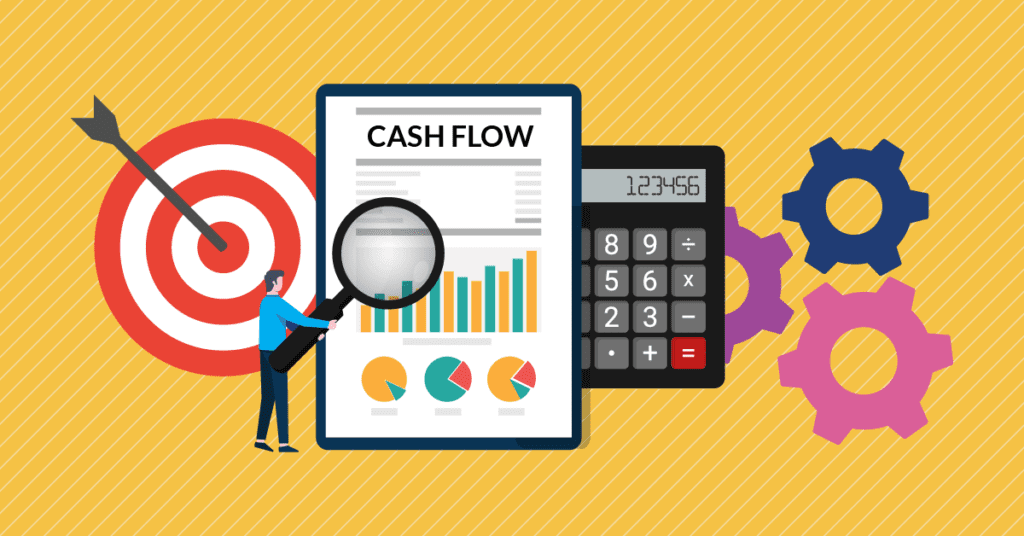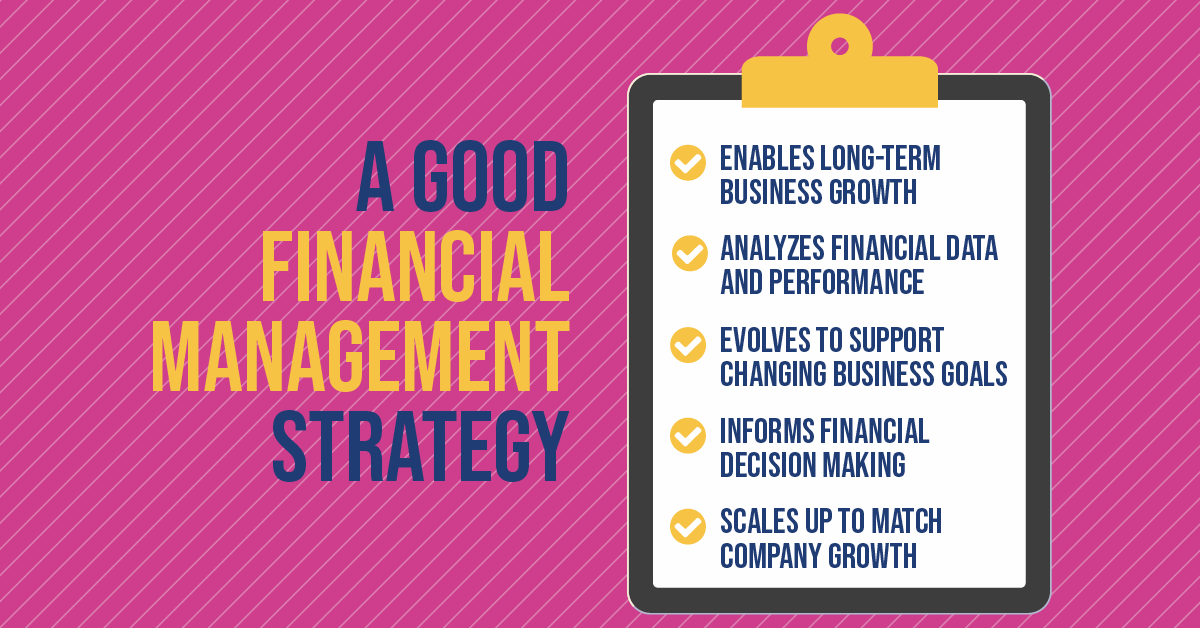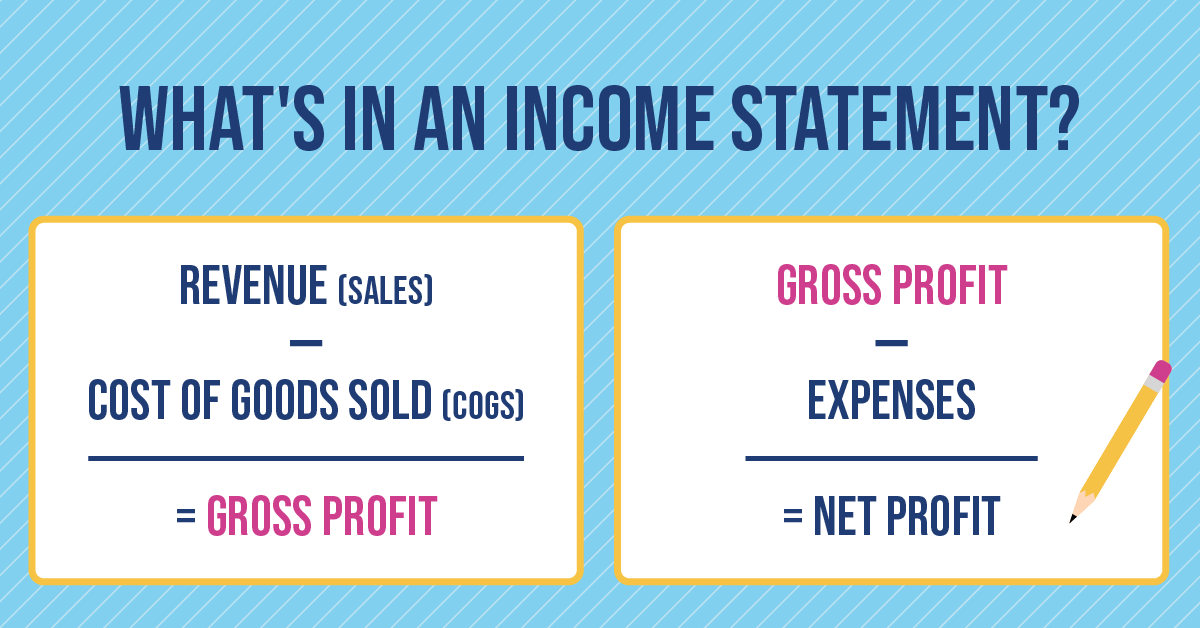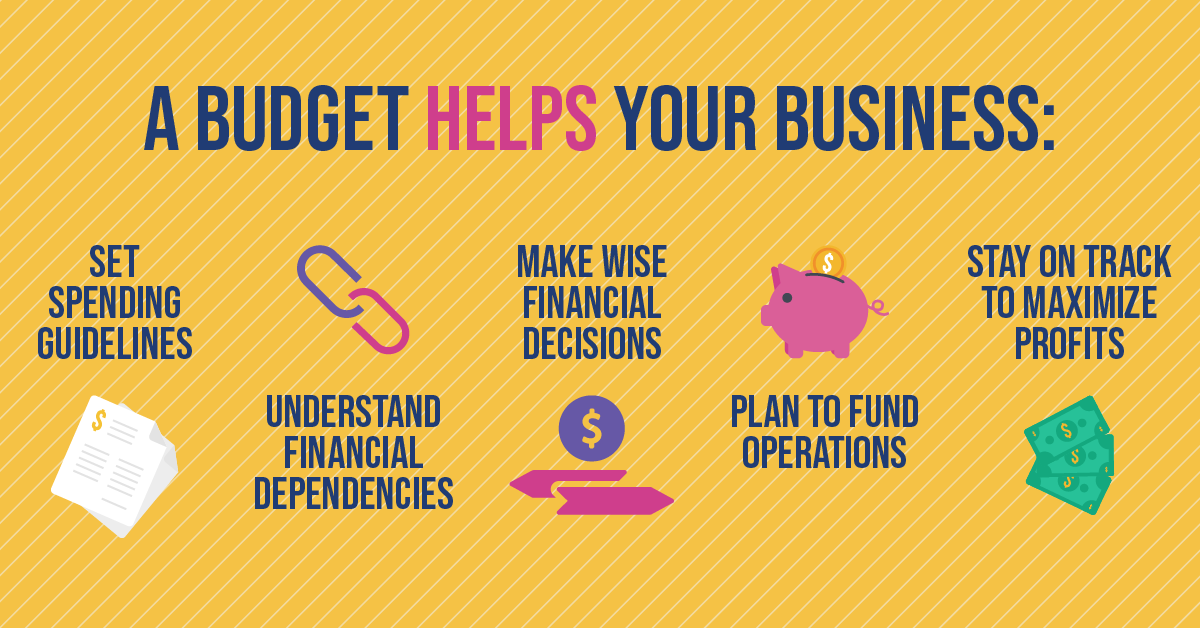Strategic Financial Management – The Quick Start Guide

Developing a financial management strategy is a critical element of corporate finance. Strategic financial management goes beyond financial planning, budgeting, managing financial resources, controlling spend and liabilities, and mitigating risk. A financial management strategy is a roadmap your CFO and finance team can use to ensure your business will have the money it needs to reach its long-term goals.
This guide breaks down the fundamentals of financial management strategy to start your planning. We’ll talk about the benefits of having a good plan, the challenges you may face, and the steps you can take to get started.
What Is a Financial Management Strategy?
At the core, financial management strategy deals with how your business uses, tracks, and controls cash flow and financial resources. The main goal of your financial management strategy is to align the financial management of your company to your business plan and goals.
The strategy ensures that your business has enough money to cover expenses in the short term and invest in long-term growth. The financial strategy includes:
- Determining the ROI of your financial decisions
- Analyzing expenditures and cash flow patterns
- Planning and managing financial resources
- Managing and mitigating risk
- Accounting and forecasting
These strategies are accomplished through budgeting, planning, setting up financial controls, processes, and systems, and incorporating financial decision-making into your company’s strategic planning process. A financial strategy enables your CFO to expand their role to provide strategic guidance and support for your business.

Benefits of Strategic Financial Management
A financial management strategy keeps your business focused on achieving its goals in the long term. The strategy helps you set your financial goals, but it provides the tools and guidelines to achieve those goals, despite any challenges. For example, a risk mitigation strategy, coupled with accurate, real-time metrics, lets you anticipate and model risks and mitigate them if (or when) they happen, rather than being caught off-guard.
Here are some other key benefits of strategic financial management:
Determine Working Capital and Credit Requirements
When you know what funds you have on hand, you can estimate what financial resources you’ll need for future expenses or business growth. You can also determine when and if you need to borrow or raise capital and what type of capital structure your business should have.
Control Expenditures and Improve Cash Flow
Spend management tools can give you a clear understanding of your expenditures and cash flow. This lets you build a budget, reduce errors, and anticipate future expenses, which is great for your cash flow and balance sheet.
Maximize ROI and Grow Your Business
When you know exactly how much money your business has on hand, you can make optimal investments in growing your business.
Make Good Financial Decisions
Armed with current and accurate data, a solid budget, and the tools you need to implement financial policies, you can make informed financial decisions to support your business. For example, analytics can help you identify areas where your business is underperforming so you can make improvements.
Challenges to Financial Management
The real test of a financial management strategy is how resilient and adaptable it is in the face of an unexpected change.

All businesses face unique financial challenges depending on their industry, structure, and market. However, most businesses face common internal and external challenges.
Internal Financial Challenges
Changes to the internal dynamics of an organization can present internal financial challenges. For example, your business may experience a big shift in growth or add new products or services, or you may enter a new market. These changes can add new pricing structures, processes, and expenditures. Some changes may also impact accounts receivable. Personnel changes, downsizing, and organizational restructuring can also affect your financial processes.
External Financial Challenges
Changes in your business environment or marketplace can significantly impact your financial management. For example, you could face a new competitor and need to change your sales and marketing strategy, resulting in a reallocation of funds or reduced revenue and profits. A shift in market demand could result in increased demand for your product, which can spur growth, or new regulatory requirements could result in high new costs to your business.
Financial Strategic Management Builds Resilience and Flexibility
A good financial management strategy takes internal and external challenges into account and provides the guidance and tools to help your business anticipate, respond, adapt, and overcome challenges. Instead of being caught off guard when the unexpected happens, which can be lethal to a business in today’s marketplace, you can prepare for challenges by modeling and forecasting scenarios and developing contingency plans to respond when they occur.
Core Elements of Strategic Financial Management
Your financial management strategy will depend on the size of your business, where it is in its lifecycle, your market, and your business goals. There’s no one-size-fits-all strategy that will work for every business, but there are four core elements of strategic financial management that you can use to build the foundations of your strategy.
Financial Planning and Goal Setting
Precisely define the goals and objectives of your strategy and how you will achieve them and measure your progress. To do this, identify and quantify your resources, get a clear picture of your current financial situation, and review your business goals. Use this data and information to build your strategy and set timelines for achieving your financial goals.
Understand Your Cash Flow
Build a profit and loss (P&L) statement to summarize your company’s income and expenses, and develop the tools and processes to track your cash flow. The P&L will let you know if your company is profitable or operating at a loss, and because the data is real-time, you will be able to make adjustments or change your strategy as needed.
Proactive Budgeting
Build a budget, keep it up to date, and stick to it. Proactive budgeting and forecasting let you set guidelines to manage expenditures, make informed financial decisions, track variances, and understand your financial dependencies to plan how you will fund your operations.
Streamline and Automate Financial Processes
Advances in software and technology have made it easier to automate and manage financial and expenditure processes and track financial data. Look at how automation can make your operations more efficient and provide you with accurate real-time financial data, analysis, and forecasting to help you achieve your goals.
Start Where You Are
Use the core strategic elements to build the foundations for your company’s financial management strategy. Then you can use this foundation to adapt your strategy to your specific business needs.
Business owners in fast-growing sectors should look to strategies that set financial goals for supporting rapid growth and innovation. For example, a small business looking to secure venture capital funding will want to provide potential investors with a clear plan for how they plan to finance product development or entry into new markets. Businesses at a more stable stage in their lifecycle should build strategies that protect assets and keep costs under control to maximize stakeholder value.
With this in mind, let’s look at each element of your financial management strategy.
Plan a Strategy: Analyze Historical Financial Statements
Take account of your company’s historical expenditures and revenues. This information can provide valuable insights into your business. For example, your financial statements can reveal trends in income and expenses, identify areas that are performing well or need improvement, or unveil places where your company faces financial risk. You can use the insights from this analysis to set your new financial goals and benchmarks.
You should review your financial statements, balance sheets, past budgets, and other financial information. Financial automation software can make this process easier and more effective by automatically collecting the financial data and storing it in one place, performing analysis and forecasts, and presenting the results in clear and concise dashboards and reports.
Watch the Money: Understand Your Cash Flow
Ideally, you’d begin tracking your cash flow – and your company’s income and expenses – from day one. As any business owner knows, business priorities get in the way, and tracking can fall behind. Larger businesses can also struggle to keep an accurate and real-time record of their cash flow. If you don’t understand how much money your company makes and spends, you’re operating in the dark.
Your P&L, or income statement, is a key component of your financial statements. It covers your company’s expenditures and sources of income for a given period, usually a month.

The financial information from your P&L gives you a clear picture of your costs to make informed decisions about growth, pricing, or cost savings. Also, as you build your P&L, you’ll get a deeper understanding of each component of your company’s financial picture.
How to Build Your P&L
One effective way to track your cash flow is to document and categorize each expense and revenue source and assign them with labels. Categorizing expenses makes it easier for you to remember all the individual components of your income statement. Get as granular as possible so you identify and track every expense that can impact your cash flow.
Store the income and expenses digitally so you can access and analyze the data whenever needed. Automated financial management solutions can also track and report your income and expenses in real-time, giving you an accurate picture of your cash flow instantly, instead of every month.
Get Proactive: Create a Budget and Use It
Your budget is one of your most important financial resources. As a business owner or CFO, you live and die by your gross profit and operating expenses. You need to manage your costs very carefully to maximize profits and ROI. A smart budget is your greatest asset in achieving your goals.
How to Start Building a Budget
The specific elements of your budget will depend on your unique business needs, but here are some of the basic questions you can ask yourself to begin allocating expenses and developing a budget:

- What are your sales and revenue projections for the budget period?
- What are the direct costs of your sales? (material or labor costs) When will those costs be incurred?
- What are your operational costs, such as expenses, payroll, commissions, marketing, entertainment and meals, rent and real estate costs, or utilities?
- What are your indirect or recurring costs, such as software licenses or subscriptions?
- How much money does your business have on hand right now?
- Are any supplier contracts renewing or expiring? Do you know the new costs if they are renewed?
- Do you have any spend commitments under an existing contract?
You can use your historical financial data to estimate your current costs and revenue and help set your current budget. Although your initial budget will usually be for a set period, usually a quarter or a fiscal year, budgeting is ongoing.
You should regularly review your actual financial data against your budget to ensure your spend is within budget and make necessary adjustments if there is a discrepancy. Automated financial management tools can make this process easier and more effective by providing real-time spend data that lets you check your current performance against your budget anytime.
Stay in Control: Use Financial Management Software to Track and Limit Expenses
Automated financial management solutions offer you the power to collect, analyze, report, and forecast financial information in real-time. Tools like payment cards, automated spend management platforms, and accounts payable dashboards give you total control over your company’s finances. You can see every transaction when it happens, reconcile your books and financial statements instantly, and make financial decisions using the most current financial data available.
How to Begin Automating Financial Management
The first step to begin automating your financial management processes is to get a clear view of your current financial situation and how your business manages money. If you follow this guide, you will have already gathered this information.
Once you get a picture of where you are, you can look at your operations and decide where automation will bring the best ROI in cost savings or increase analytical capabilities. Stampli has a great guide to expense management automation that will help you get started with selecting and implementing automation tools.
PCards: Monitor and Control Expenditures in Real-Time
Payment cards are a powerful way to stay on top of employee expenses. You can set spending limits with payment cards, restrict card use to a single employee, or assign a card to a specific project or spend category. Pcard solutions also can monitor expenses and approvals in real-time, which helps you reduce expense errors and eliminate fraud.
Visualize Your Financial Data with Dashboards
Some spend automation platforms, such as Stampli, offer dashboards that let you visualize your financial data. Dashboards let CFOs and finance teams see data, reports, and key performance indicators at a glance.
Some dashboards provide analytic capabilities, so you can drill down into the data to gain deeper insights into your financial performance. For example, a dashboard can help CFOs understand AP team members’ workloads and performance or let controllers identify and manage outstanding supplier invoices.
Financial management automation should be a top priority for any modern business developing a financial management strategy. Automation makes your business more resilient and agile, a significant competitive advantage in today’s hyper-competitive marketplace. Many financial automation vendors also provide advisory services to help you redesign your financial processes and implement an automation platform.
Stampli: Empower Your Financial Management Strategy
Businesses are spoiled for choices for automated financial management solutions, but Stampli’s cloud-based, AI-powered AP automation solution sets us apart.
Stampli helps your business process expenses fast and efficiently, saving you time and money. Here’s how we do it:
Stampli Card – Control Expenses
Stampli Card goes beyond vanilla Pcards to accelerate your expense and approval processes control shadow spend, and prevent fraud. You can print personal cards to track and manage each employee’s spending, restrict cards to authorized employees, and impose preset spending limits.
Gain Total Control – Expense Process Automation
Stampli’s AI-powered approach to AP automation lets you see and track your financial data when an expense is incurred. You can automate and gain control over almost every process in your expense cycle, anticipate and mitigate risks, and make informed spending decisions.
Stampli Dashboards – Visualize Your Financial Data
Stampli’s end-to-end platform gives full visibility over all your corporate spending in one place. Stampli Dashboards and interactive widgets let you see real-time, accurate financial data and analytics at a glance and make informed financial decisions.
Get a free demo of Stampli and learn how you can empower your financial management strategy today!
